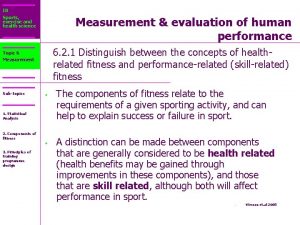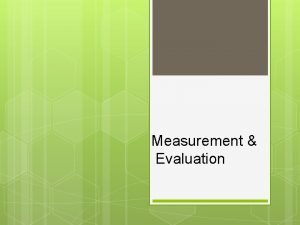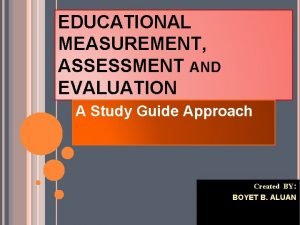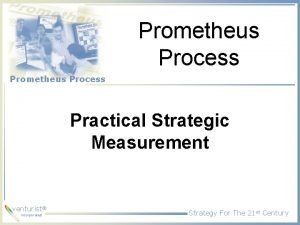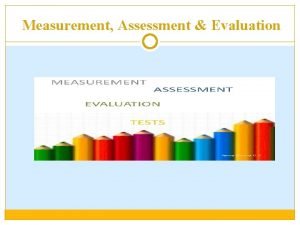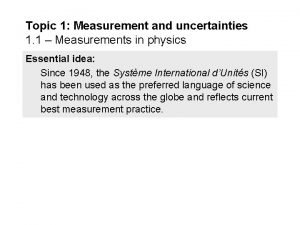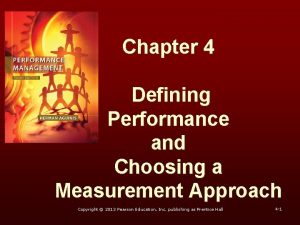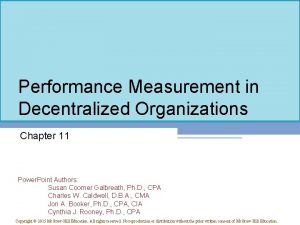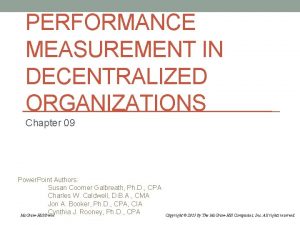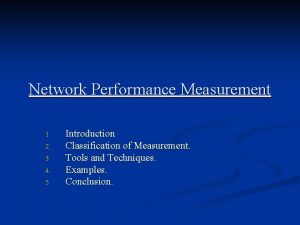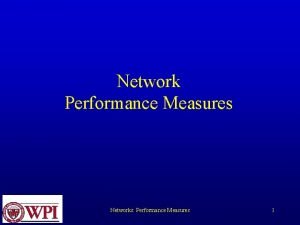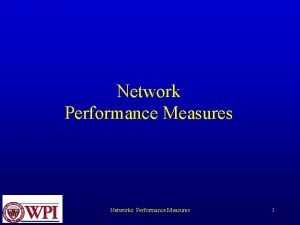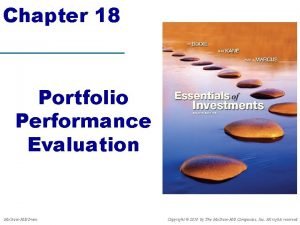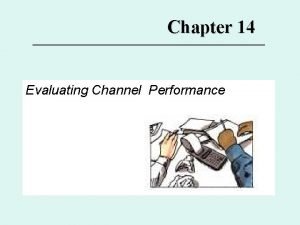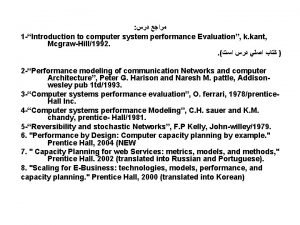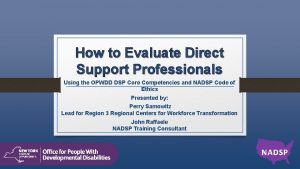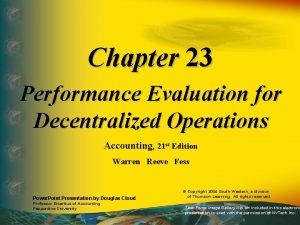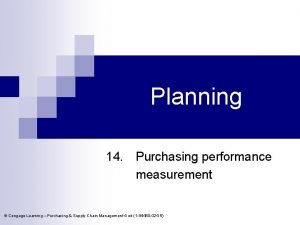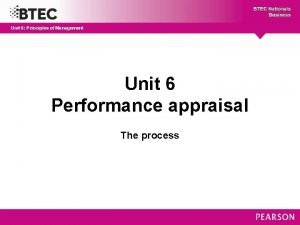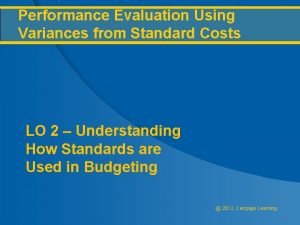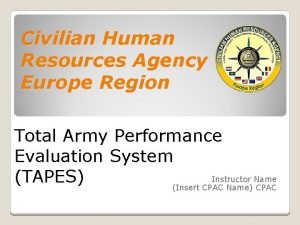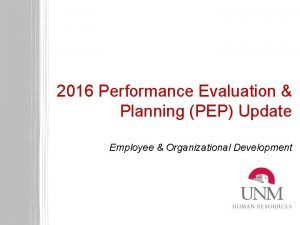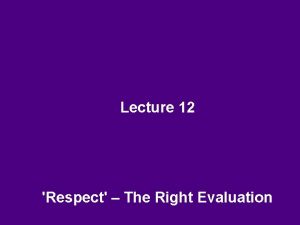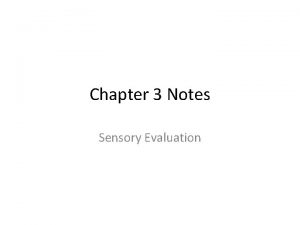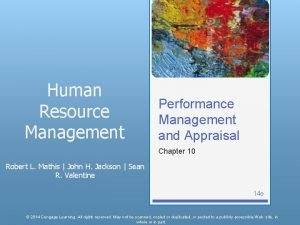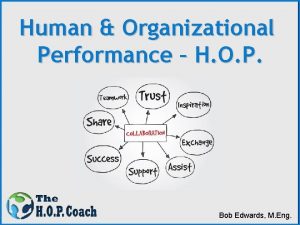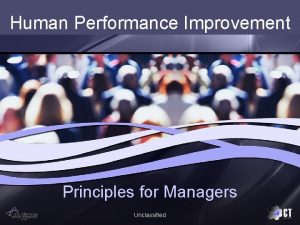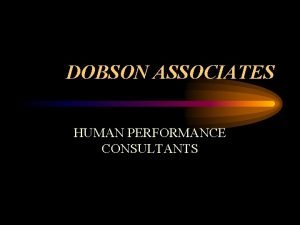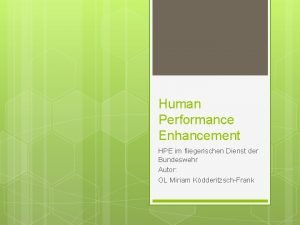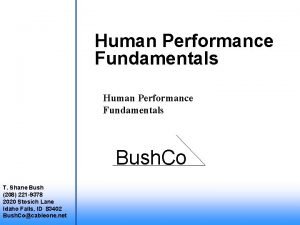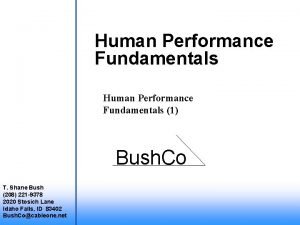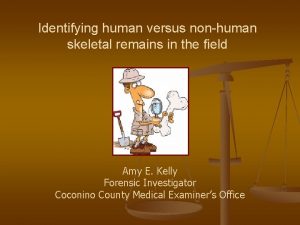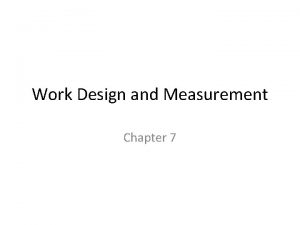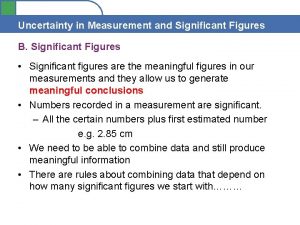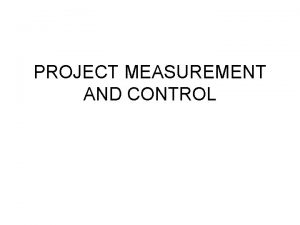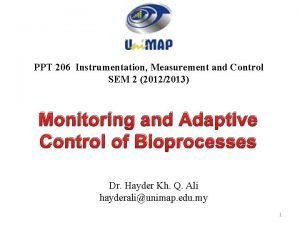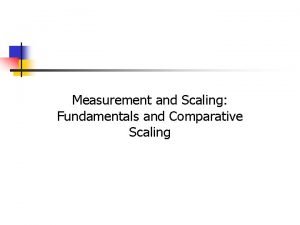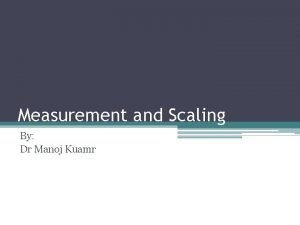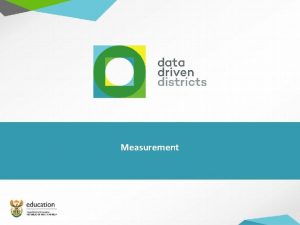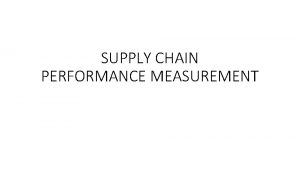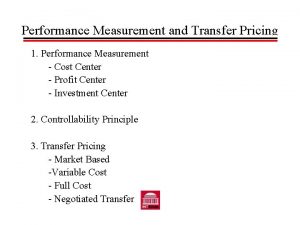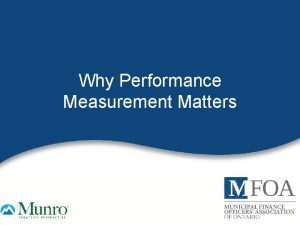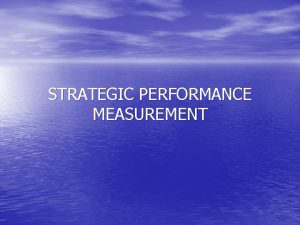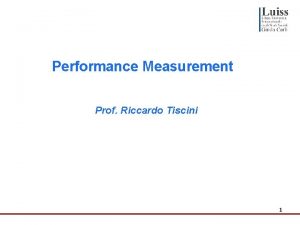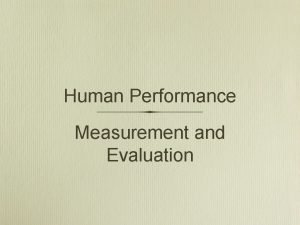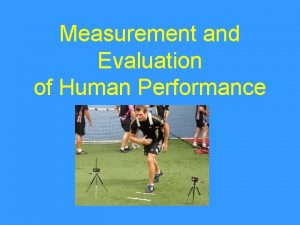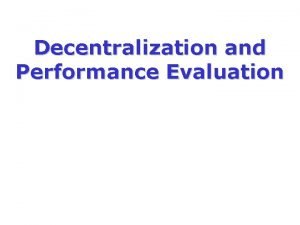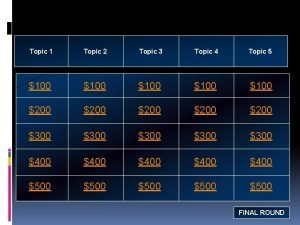Topic 6 Measurement and evaluation of human performance















































































- Slides: 79

Topic 6: Measurement and evaluation of human performance 6. 1 Statistical Analysis

Topic 6: Measurement of human performance Why do we want to measure human performance? When we measure it, how do we analyze and use the information? Chapter 6 is teaching you how to gather data, how to design a fitness test, and how to assess different studies First - we need to understand all of the statistical terms and types of measurement techniques

Standard Deviation 6. 1. 1 Outline that error bars are a graphical representation of the variability of data 6. 1. 3 State that the statistic standard deviation is used to summarize the spread of values around the mean The spread of scores around the mean or average When the data are normally distributed, about 68% of all values will lie within +/- 1 standard deviation while 95% will be within +/- 2 standard deviations

Error bars 6. 1. 1 Outline that error bars are a graphical representation of the variability of data A graphic representation of the variability of data

6. 1. 2 Calculate the mean and standard deviation of a set of values Mean= Average Standard Deviation Calculate using a calculator! Do not need to remember formula

6. 1. 4 Explain how the standard deviation is useful for comparing the means and the spread of data between two or more samples A small standard deviation indicates that the data is clustered closely around the mean value Conversely, a large standard deviation indicates a wider spread around the mean ADD MORE – RELATE TO REAL FINDINGS

Coefficient of Variation 6. 1. 5 Outline the meaning of coefficient of variation Denoted by the letter V It is the ratio of the standard deviation to the mean expressed as a percentage By calculating the coefficient of variation you are seeing what percent of your results are equal to the mean of the data Provides similar information to SD but since it is expressed as a % it is easier for people to understand

Coefficient of Variation 6. 1. 5 Outline the meaning of coefficient of variation Useful statistic for comparing the degree of variation from one series to another, even if the means are drastically even one another You can compare data sets when the units are different

Practice Calculating Mean, Standard Deviation and Coefficient of Variation with Mary and Roisin

6. 1. 6 Deduce the significance between two sets of data using calculated values for t and the appropriate tables The t test (also called Student’s T Test) compares two averages (means) and tells you if they are different from each other. The t test also tells you how significant the differences are; In other words it lets you know if those differences could have happened by chance For the t test to be applied, ideally the data should have a normal distribution and a sample size of at least 10 Statisticshowto. com

6. 1. 6 Deduce the significance between two sets of data using calculated values for t and the appropriate tables A very simple example: Let’s say you have a cold and you try a naturopathic remedy. Your cold lasts a couple of days. The next time you have a cold, you buy an over-the-counter pharmaceutical and the cold lasts a week. You survey your friends and they all tell you that their colds were of a shorter duration (an average of 3 days) when they took the homeopathic remedy. What you really want to know is, are these results repeatable? A t test can tell you by comparing the means of the two groups and letting you know the probability of those results happening by chance. Another example: Student’s T-tests can be used in real life to compare means. For example, a drug company may want to test a new cancer drug to find out if it improves life expectancy. In an experiment, there’s always a control group (a group who are given a placebo, or “sugar pill”). The control group may show an average life expectancy of +5 years, while the group taking the new drug might have a life expectancy of +6 years. It would seem that the drug might work. But it could be due to a fluke. To test this, researchers would use a Student’s t-test to find out if the results are repeatable for an entire population. Statisticshowto. com

6. 1. 6 Deduce the significance between two sets of data using calculated values for t and the appropriate tables If you want to use the tables to determine p-value using a t-test, you must know the degrees of freedom Paired t-test – degrees of freedom is one less than your n Use this when the same people are tested Unpaired t-test – degrees of freedom is two less than n Statisticshowto. com

6. 1. 7 Explain that the existence of a correlation does not establish that there is a causal relationship between two variables Correlation tells us if there is a relationship (or correlation) between two things i. e. – is there a correlation between athletes’ ages and times for the 5000 meters We do this by calculating the r and r 2 values

6. 2 Study Design

6. 2. 1 Outline the importance of specificity, accuracy, reliability and validity with regard to fitness testing What are the main factors involved in ensuring that we are correctly measuring an individual’s fitness level? Specificity Accuracy Reliability Validity

6. 2. 1 Outline the importance of specificity, accuracy, reliability and validity with regard to fitness testing Specificity Is the test you are choosing specific to the sport/activity in which the person participates? Question – would a 1 -mile timed running test be a specific test to assess strength in a power lifter?

6. 2. 1 Outline the importance of specificity, accuracy, reliability and validity with regard to fitness testing Accuracy Is the equipment we are using to test the participant calibrated for accuracy?

6. 2. 1 Outline the importance of specificity, accuracy, reliability and validity with regard to fitness testing Reliability? “The degree to which a measure would produce the same result from one occasion to another” Inter and Intra rater reliability Tests can be unreliable when there is a learning or habituation effect If this occurs, you may need practice sessions to allow participants learn task fully – reach the point where they can get no better

6. 2. 1 Outline the importance of specificity, accuracy, reliability and validity with regard to fitness testing Validity Does the test measure what it claims to measure?

Choose a sport or physical activity and devise a specific, accurate and valid test of overall performance of one aspect of performance. How would you test reliability?

6. 2. 2 Discuss the importance of study design in the context of the sports, exercise and health sciences What factors should you take into account when designing sport and exercise science experiments? Control Groups Randomization Placebos Blinding and Double Blinding Statistical Analysis

6. 2. 2 Discuss the importance of study design in the context of the sports, exercise and health sciences Control Group The control group is defined as the group in an experiment or study that does not receive treatment by the researchers and is then used as a benchmark to measure how the other tested subjects do

6. 2. 2 Discuss the importance of study design in the context of the sports, exercise and health sciences Placebo A substance that has no therapeutic effect, used as a control in testing new drugs

6. 2. 2 Discuss the importance of study design in the context of the sports, exercise and health sciences Randomization A method based on chance alone by which study participants are assigned to a treatment group Randomization minimizes the differences among groups by equally distributing people with particular characteristics among all the trial arms. The researchers do not know which treatment is better

6. 2. 2 Discuss the importance of study design in the context of the sports, exercise and health sciences Blinding and Double Blinding An RCT may be blinded, (also called "masked") by "procedures that prevent study participants, caregivers, or outcome assessors from knowing which intervention was received Double Blinding A double-blind study is one in which neither the participants nor the experimenters know who is receiving a particular treatment. This procedure is utilized to prevent bias in research results. Double-blind studies are particularly useful for preventing bias due to demand characteristics or the placebo effect

Study Design – pre and post test – discussion of caffeine example from book Cause and Effect Experiment Question – Does taking caffeine tablets have an effect on starting time in a 100 meter race? Design – Pretest----Treatment (caffeine ingestion)----Post Test Problems with this experimental design? ?

Study Design – pre and post test – discussion of caffeine example from book Cause and Effect Experiment How do you overcome learning/habituation problem – use control group Experimental group---Pre-Test----Treatment (caffeine)----Post-Test Control group-----Pre-Test----No treatment------Post-Test Problems with this design?

Study Design – pre and post test – discussion of caffeine example from book Cause and Effect Experimental group----Pre-Test----Treatment (caffeine)---Post Test Control group----Pre-Test-----Treatment (placebo)----Post Test Problems? ?

Study Design – pre and post test – discussion of caffeine example from book Cause and Effect Experiment Blinding and Randomization

Come up with your own cause and effect experiment

What is the Par-Q 6. 2. 3 Outline the importance of the PAR-Q Physical Activity Readiness Questionnaire is a screening tool used to determine if participating in physical activity of physical tests will put their health or life at risk If the person answers “No” to all questions then they can continue with physical activity If they answer ”Yes” to one or more questions they must see their doctor before undertaking any physical tests, training programs or sports

6. 2. 4 Evaluate field, laboratory, sub -maximal and maximal tests of human performance So, you’ve determined your client is healthy enough to undertake testing (due to normal PAR-Q) – now which test or tests of fitness do we use? Remember the criteria outlined earlier with regard to testing – are the tests Specific Accurate Reliable Valid

6. 2. 4 Evaluate field, laboratory, sub -maximal and maximal tests of human performance First thing – decide what you want to test i. e. – you want to know what someone’s VO 2 max is Laboratory tests are the best – is the lab available? If not, may need to use a field test instead such as bleep test or Cooper’s 12 -minute run test Not as accurate or reliable but may be only thing that is available

6. 2. 4 Evaluate field, laboratory, sub -maximal and maximal tests of human performance

6. 2. 4 Evaluate field, laboratory, sub -maximal and maximal tests of human performance Maximal test We want to know the maximal amount a person can do (i. e. VO 2 max or maximal weight they can lift) – carrying out a maximal test meets all of the criteria Sub-maximal tests Used if you think a person will not be able to complete the max test – Maximal number is calculated based on submax results Example – Bruce Protocol and Modified Bruce Protocol

6. 2. 4 Evaluate field, laboratory, sub -maximal and maximal tests of human performance

6. 3 Components of fitness

6. 3. 1 Distinguish between the concepts of health-related fitness and performancerelated (skillrelated) fitness Health-related fitness Definition: an individual’s physical ability to maintain health and perform activities of daily living Consists of: Body composition Cardio-respiratory fitness (aerobic capacity) Flexibility Muscular endurance Strength

6. 3. 1 Distinguish between the concepts of health-related fitness and performancerelated (skillrelated) fitness Performance-related fitness Definition: an individual’s physical ability to perform in a specific sport Consists of: Agility Balance Coordination Power Reaction time Speed

6. 3. 1 Distinguish between the concepts of health-related fitness and performancerelated (skillrelated) fitness Note: Some components of performance-related fitness (agility, balance, coordination) could become health-related for certain groups such as the elderly and those suffering from hypokinetic diseases A disease brought on, at least in part, by insufficient movement and exercise. Hypokinesis has been identified as an independent risk factor for the origin and progression of several widespread chronic diseases, including coronary heart disease, diabetes, obesity, and lower back pain

Body composition Health-Related Fitness Proportion of an individual’s total body mass that is made up of fat and fat-free mass Total body mass is easy to assess – is therefore often measured and interpreted in relation to health and sports performance – in both contexts what makes up this total body mass is actually more important Body fat mass – essential fat found in tissues and organs as stored fat Free fat mass – what makes up the rest of the total body mass – muscle, water and bone

Excess body fat, when located centrally around the abdomen, is associated with chronic conditions including hypertension, metabolic syndrome, Type 2 diabetes mellitus, stroke, cardiovascular disease, and dyslipidemia Body Composition Approximately 2/3 of American adults are classified as overweight or obese (BMI > or = 25 kg. ) and more than 1/3 are classified as obese (BMI > or = 30 kg) Norms Men – 10 -22% Women 20 -32%

How do you assess Body Composition? Hydrostatic Weighing Body Composition Anthropometric Measurements Skinfold and Girth Measurements BMI Bioelectrical Impedance Analysis

Body Composition

Cardio-respiratory fitness (aerobic capacity) Health-Related Fitness Ability to take in, deliver and use oxygen Most commonly characterized by individual’s maximal oxygen uptake – VO 2 Max – which is the maximal rate that oxygen can be used during maximal exercise Also referred to as aerobic capacity Cardio-respiratory fitness is limited by the limits of the cardiovascular and ventilatory systems to take O 2 from the atmosphere, deliver to tissues and use it

Cardio-respiratory fitness (aerobic capacity) Health-Related Fitness Cardiorespiratory fitness is important for health and sport because: Low-levels of CV fitness are associated with many disease states and an association with a shorter lifespan With impaired CV system, only low intensities of physical activity can be tolerated before anaerobic systems kick in – and they are less sustainable In contrast, high levels of CV fitness enable much higher duration and intensity of physical fitness

How do we assess this? Cardiorespiratory Fitness Open Circuit Spirometry/Indirect Calorimetry Subject breathes through valve with nose occluded, while pulmonary ventilation and expired fractions of O 2 and CO 2 are measured Gold Standard Laboratory Test Max Test

Cardiorespiratory Fitness What if these aren’t available?

Can use: Cardiorespiratory Fitness Field Tests Cooper 12 -minute test Rockport One-Mile Fitness Walking test Submax Exercise Tests Cycle Ergometer Tests (Astrand-Rhyming) Treadmill Test (Modified Bruce Protocol) Step Test (Harvard Step Test)

Flexibility Ability to move through the full range of motion around a joint Health-Related Fitness Limited by multiple factors: Capacity of muscles and tendons to stretch Ligament condition Joint mechanics Size and shape of bones

How do we assess? Range of Motion Norms – goniometer Sit and Reach Test Flexibility

Muscular endurance Health-Related Fitness The ability of a muscle or muscle group maintain force or power Also described as fatigue-resistance Typically, local muscular endurance is mostly related to the availability of substrates, enzyme activity and build-up of metabolites, although nervous system plays a very important role

How do we assess? Muscular Endurance Push-Up Test Curl-Up Test

Strength Health-Related Fitness Ability to generate force by a muscle or muscle group Dependent on Muscle mass that is available (volume and fiber type) Ability to activate the muscle mass Coordination of muscle activity Overall, the interaction of neural and muscular systems

Ways to Assess? Strength Hand-held dynamometer Grip strength dynamometer 1 -RM, 5 -10 RM Bench or shoulder press, leg press or knee extension

Agility Performancerelated fitness Ability to rapidly change direction or speed What controls agility is very complex Includes factors including strength, power, speed, flexibility, balance, peripheral vision, anticipation and experience

Ways to assess? Agility Illinois Agility Test 5 -0 -5 Agility Test

Balance Refers to the stability of the body Performancerelated fitness To maintain balance the center of gravity needs to be maintained above the supporting base of the body Achieved through coordinated contraction and relaxation of postural muscles in response to positional changes Positional changes are detected by visual, vestibular and proprioceptive processes Input from these systems stimulate coordinated muscular responses in order to maintain balance

How to assess? Balance Stork Stand

Coordination Performancerelated fitness The ability to move two or more body parts under control, smoothly and efficiently

How to assess? Coordination Hand Ball Toss

Power Defined as the rate of doing work Performancerelated fitness Functionally, it represents the combination of force and velocity or strength and speed High forces = strength Low forces = speed Often seen as one of the most important determinants of sporting performance

How to assess? Power Vertical Jump Standing broad Jump

Reaction time Duration between the presentation of a stimulus and the associated response Performancerelated fitness Depends on integration of the neuromuscular systems Reflects: Combination of detecting sensory information Processing this information Sending a response Effecting this response

How to assess? Reaction Time Drop Test Computer simulation

Speed Performancerelated fitness Change of distance with respect to time when movement occurs Could refer to whole-body speed or speed of a particular joint or muscle group Determined by interactions of biomechanics and physiology Speed has more relevance for performance-related fitness than health-related fitness

How to assess? Speed 40 meter sprint

Health assessment – what can it show us? Primarily used to evaluate health and identify weaknesses relative to healthy “norms” Can assist with diagnosis, assessment of severity and prognosis Why is fitness assessed? Testing can monitor progress with interventions, assist with education of participants/patients, and design individual training programs Performance assessment – what can it show us? Same as above plus Provide feedback to athletes Predict performance potential Establish goals for athletes to work towards

6. 3. 3 Outline and evaluate a variety of fitness tests Tests for Aerobic Capacity Multistage fitness test/Bleep test (Leger test) Cooper’s 12 -minute run Harvard step test

Multistage fitness test/Bleep test (Leger test) Description of test 6. 3. 3 Outline and evaluate a variety of fitness tests Participants perform repeated 20 -meter shuttles at progressively increasing speeds until exhaustion is reached First level is at low intensity Approx. each minute the frequency of the sounds increases to next level, causing an increase in running speed Performance in the test is described as the level reached and the number of completed shuttles in that level before participant voluntarily stops or fails to keep pace Score is compared against a reference table where an estimate of VO 2 max can be obtained Higher score corresponds with higher VO 2 max

Multistage fitness test/Bleep test (Leger test) 6. 3. 3 Outline and evaluate a variety of fitness tests Advantages Limitations Limited experience and equipment needed Prediction based on performance and not direct measurement Maximal test (not a sub-maximal prediction), so similar to gold standard Maximal test (safety and ethical considerations, as well as importance of motivation Easy to score Environmental factors influence performance as not in laboratory Large numbers can be tested at once in a Score is known by participants and short time previous scores or target scores may impact on performance The protocol is stop-start in nature, compared to continuous in the gold standard

Multistage fitness test/Bleep test (Leger test) Reliability and Validity? 6. 3. 3 Outline and evaluate a variety of fitness tests Shown to be reliable with healthy adults in sports teams Provided test is carefully standardized and reasonably accurate for estimation of VO 2 max Sensitive to training improvements, i. e. improvements in score will indicate improvement in aerobic fitness For other populations alternative data are required Not appropriate for people with pre-existing medical conditions

Cooper’s 12 -minute run 6. 3. 3 Outline and evaluate a variety of fitness tests Participants run/walk as far as they can in a period of 12 minutes Total distance is entered into an equation to estimate VO 2 max

Cooper’s 12 -minute run 6. 3. 3 Outline and evaluate a variety of fitness tests Advantages Limitations Limited experience and equipment needed Prediction based on performance and not direct measurement Maximal test (not a sub-maximal prediction) with continuous exercise Maximal test (safety and ethical considerations, as well as importance of motivation) Easy to score Environmental factors influence performance as not in laboratory Large numbers can be tested at once in The protocol is not progressive in a short time nature and therefore pacing will be a key factor

Cooper’s 12 -minute run 6. 3. 3 Outline and evaluate a variety of fitness tests Similar to the MSFT test, Cooper’s is widely used in nonclinical populations and same limitations apply Since the protocol is continuous and self-paced, participants are more comfortable with the test and may perform better than the MSFT

Harvard Step Test 6. 3. 3 Outline and evaluate a variety of fitness tests Participants are required to step on an off a step (45 cm high) at a rate of 30 steps each minute for 5 minutes making a total of 150 steps completed The heart rate of the participant is then measured at the 1 st, 2 nd, and 3 rd minutes of recovery following completion of the test Equation uses the total of these three heart rate values to estimate VO 2 max , based on the association of a lower heart rate (and faster recovery) at a fixed intensity with higher VO 2 max

Harvard Step Test 6. 3. 3 Outline and evaluate a variety of fitness tests Advantage – does not require participants to exercise maximally, making it safer to conduct on a wide variety of participants Less accurate unless alternative equations are used for differing populations This test is more suitable for assessment of health-related fitness than sport-related fitness

Harvard Step Test 6. 3. 3 Outline and evaluate a variety of fitness tests Advantages Limitations Limited expertise and equipment needed Prediction based on heart rate values Sub-maximal test (suitable for more participants) with continuous exercise Does not account for individual variation in heart rate (not trainingrelated) The test is based on physiological findings and not performance (pacing and motivation will not affect the results) Heart rate needs to be measured accurately, as small differences will impact on the result

IN CLASS ASSIGNMENT – EVALUATION OF OTHER FITNESS TESTS 6. 3. 3 Outline and evaluate a variety of fitness tests Body Composition Speed BMI, anthropometry and underwater weighing The 40 meter sprint Flexibility The Sit-and-Reach Test Muscle Endurance Maximum sit ups, maximum push ups, flexed arm hang Agility The Illinois agility test Strength The handgrip test using a handgrip dynamometer Balance The standing stork test Reaction time The ruler drop test Also look at computer-based tests of reaction time Power Vertical jump and standing broad jump
 Measurement and evaluation in human performance 5e download
Measurement and evaluation in human performance 5e download Vertical jump
Vertical jump Progress and performance measurement and evaluation
Progress and performance measurement and evaluation Evaluation in progress
Evaluation in progress Example of specific topic
Example of specific topic Narrowing down a topic exercises
Narrowing down a topic exercises Concept map of measurement assessment and evaluation
Concept map of measurement assessment and evaluation Prognostic test
Prognostic test Strategic measurement and evaluation
Strategic measurement and evaluation Concept of measurement assessment and evaluation
Concept of measurement assessment and evaluation Measurement and evaluation for health educators
Measurement and evaluation for health educators Measurements and uncertainties ib physics
Measurements and uncertainties ib physics Scale in mathematical literacy
Scale in mathematical literacy Result approach in measuring performance
Result approach in measuring performance Approaches to measuring performance
Approaches to measuring performance Topic 7 economic performance and challenges
Topic 7 economic performance and challenges Performance measurement in decentralized organizations
Performance measurement in decentralized organizations Performance measurement in decentralized organizations
Performance measurement in decentralized organizations Network performance measurement tools
Network performance measurement tools Security performance management
Security performance management Comparative performance measurement system
Comparative performance measurement system Network performance measurement tools
Network performance measurement tools Quantum performance measurement
Quantum performance measurement Network performance measures
Network performance measures Network performance measurement in computer networks
Network performance measurement in computer networks Router node
Router node Project evaluation and control
Project evaluation and control Computer architecture performance evaluation methods
Computer architecture performance evaluation methods Portfolio performance evaluation problems
Portfolio performance evaluation problems Evaluating sales performance
Evaluating sales performance Importance of evaluating channel member performance
Importance of evaluating channel member performance Computer system performance evaluation
Computer system performance evaluation Pes usmc
Pes usmc Direct support professional performance evaluation
Direct support professional performance evaluation Performance evaluation for decentralized operations
Performance evaluation for decentralized operations Evaluating purchasing performance
Evaluating purchasing performance Citibank performance evaluation case study
Citibank performance evaluation case study Housekeeping performance improvement plan
Housekeeping performance improvement plan Unit 6 principles of management
Unit 6 principles of management Stronge leader effectiveness performance evaluation model
Stronge leader effectiveness performance evaluation model Performance evaluation using variances from standard costs
Performance evaluation using variances from standard costs Library staff performance evaluation
Library staff performance evaluation Channel performance evaluation
Channel performance evaluation Performance evaluation model
Performance evaluation model Chra europe
Chra europe Unm pep
Unm pep Right evaluation is
Right evaluation is Sensory evaluation cryptogram answers
Sensory evaluation cryptogram answers Sensory evaluation the human factor
Sensory evaluation the human factor Sensory evaluation cryptogram
Sensory evaluation cryptogram Behaviorally anchored rating scale
Behaviorally anchored rating scale Behaviorally anchored rating scale
Behaviorally anchored rating scale All performance attributes designated as joint performance
All performance attributes designated as joint performance 8.3 human needs
8.3 human needs Chapter 8 human needs and human development
Chapter 8 human needs and human development Non human nouns
Non human nouns Mbo performance appraisal method
Mbo performance appraisal method Performance appraisal in human resource management
Performance appraisal in human resource management Human performance fundamentals
Human performance fundamentals Human organizational performance
Human organizational performance Time out for safety
Time out for safety Fatigueed
Fatigueed Human performance improvement principles
Human performance improvement principles Human performance consultants
Human performance consultants Human performance principles
Human performance principles Human performance improvement tools
Human performance improvement tools Human performance enhancement
Human performance enhancement Ecology of human performance model
Ecology of human performance model Human performance fundamentals
Human performance fundamentals Human performance fundamentals
Human performance fundamentals Human vs non human bones
Human vs non human bones Gni definition ap human geography
Gni definition ap human geography Picme2.0
Picme2.0 Chapter 7 work design and measurement
Chapter 7 work design and measurement Significant figures rules
Significant figures rules Direct and indirect measurement
Direct and indirect measurement Fundamentals of instrumentation and measurement ppt
Fundamentals of instrumentation and measurement ppt If you can't measure it it doesn't exist meaning
If you can't measure it it doesn't exist meaning Comparative scaling techniques
Comparative scaling techniques Measurement and scaling
Measurement and scaling
